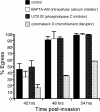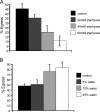Exit from host cells by the pathogenic parasite Toxoplasma gondii does not require motility
- PMID: 17993573
- PMCID: PMC2224157
- DOI: 10.1128/EC.00301-07
Exit from host cells by the pathogenic parasite Toxoplasma gondii does not require motility
Abstract
The process by which the intracellular parasite Toxoplasma gondii exits its host cell is central to its propagation and pathogenesis. Experimental induction of motility in intracellular parasites results in parasite egress, leading to the hypothesis that egress depends on the parasite's actin-dependent motility. Using a novel assay to monitor egress without experimental induction, we have established that inhibiting parasite motility does not block this process, although treatment with actin-disrupting drugs does delay egress. However, using an irreversible actin inhibitor, we show that this delay is due to the disruption of host cell actin alone, apparently resulting from the consequent loss of membrane tension. Accordingly, by manipulating osmotic pressure, we show that parasite egress is delayed by releasing membrane tension and promoted by increasing it. Therefore, without artificial induction, egress does not depend on parasite motility and can proceed by mechanical rupture of the host membrane.
Figures









Similar articles
-
Toxoplasma gondii: induction of egress by the potassium ionophore nigericin.Int J Parasitol. 2007 Dec;37(14):1559-67. doi: 10.1016/j.ijpara.2007.05.010. Epub 2007 Jun 9. Int J Parasitol. 2007. PMID: 17618633 Free PMC article.
-
Ionophore-resistant mutants of Toxoplasma gondii reveal host cell permeabilization as an early event in egress.Mol Cell Biol. 2000 Dec;20(24):9399-408. doi: 10.1128/MCB.20.24.9399-9408.2000. Mol Cell Biol. 2000. PMID: 11094090 Free PMC article.
-
The effect of kinase, actin, myosin and dynamin inhibitors on host cell egress by Toxoplasma gondii.Parasitol Int. 2013 Oct;62(5):475-82. doi: 10.1016/j.parint.2013.04.006. Epub 2013 Apr 25. Parasitol Int. 2013. PMID: 23624149
-
Gliding motility powers invasion and egress in Apicomplexa.Nat Rev Microbiol. 2017 Nov;15(11):645-660. doi: 10.1038/nrmicro.2017.86. Epub 2017 Sep 4. Nat Rev Microbiol. 2017. PMID: 28867819 Review.
-
The role of the cytoskeleton in host cell invasion by Toxoplasma gondii.Behring Inst Mitt. 1997 Mar;(99):90-6. Behring Inst Mitt. 1997. PMID: 9303207 Review.
Cited by
-
Overview of Poultry Eimeria Life Cycle and Host-Parasite Interactions.Front Vet Sci. 2020 Jul 3;7:384. doi: 10.3389/fvets.2020.00384. eCollection 2020. Front Vet Sci. 2020. PMID: 32714951 Free PMC article. Review.
-
Enhanced egress of intracellular Eimeria tenella sporozoites by splenic lymphocytes from coccidian-infected chickens.Infect Immun. 2011 Aug;79(8):3465-70. doi: 10.1128/IAI.01334-10. Epub 2011 May 31. Infect Immun. 2011. PMID: 21628515 Free PMC article.
-
Pyrimidinergic Receptor Activation Controls Toxoplasma gondii Infection in Macrophages.PLoS One. 2015 Jul 20;10(7):e0133502. doi: 10.1371/journal.pone.0133502. eCollection 2015. PLoS One. 2015. PMID: 26192447 Free PMC article.
-
Prison break: pathogens' strategies to egress from host cells.Microbiol Mol Biol Rev. 2012 Dec;76(4):707-20. doi: 10.1128/MMBR.00024-12. Microbiol Mol Biol Rev. 2012. PMID: 23204363 Free PMC article. Review.
-
Toxoplasma gondii excretion of glycolytic products is associated with acidification of the parasitophorous vacuole during parasite egress.PLoS Pathog. 2022 May 5;18(5):e1010139. doi: 10.1371/journal.ppat.1010139. eCollection 2022 May. PLoS Pathog. 2022. PMID: 35512005 Free PMC article.
References
-
- Buitrago-Rey, R., J. Olarte, and J. E. Gomez-Marin. 2002. Evaluation of two inhibitors of invasion: LY311727 [3-(3-acetamide-1-benzyl-2-ethyl-indolyl-5-oxy)propane phosphonic acid] and AEBSF [4-(2-aminoethyl)-benzenesulphonyl fluoride] in acute murine toxoplasmosis. J. Antimicrob. Chemother. 49871-874. - PubMed
-
- Chernomordik, L. V., M. M. Kozlov, G. B. Melikyan, I. G. Abidor, V. S. Markin, and Y. A. Chizmadzhev. 1985. The shape of lipid molecules and monolayer membrane-fusion. Biochim. Biophys. Acta 812643-655.
Publication types
MeSH terms
Substances
Grants and funding
LinkOut - more resources
Full Text Sources

